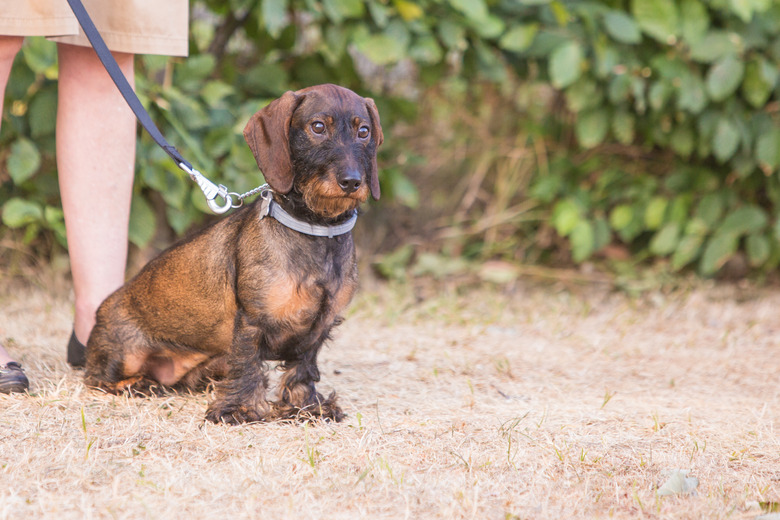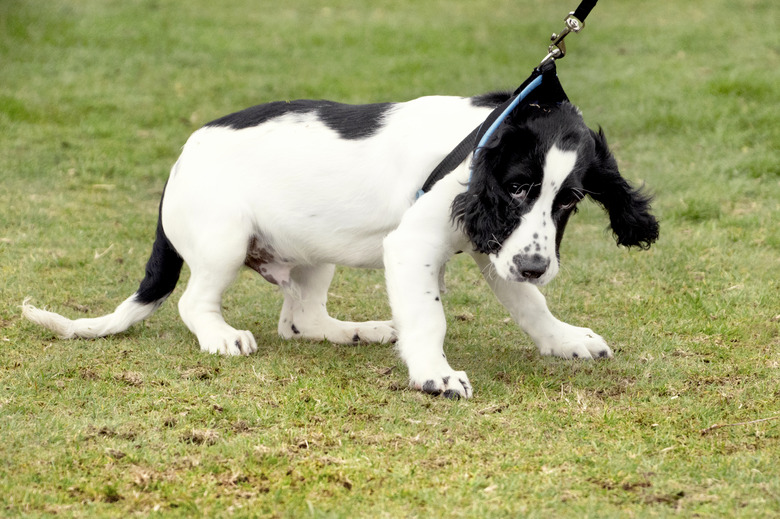Why Does My Dog Stop While We're On Walks?
If you're a dog owner or someone who finds yourself regularly walking a dog, you may have found yourself on one end of a taut leash, unable to move along your merry way. On the other end of that leash? A seemingly stubborn dog who refuses to budge, forcing you to stop. Whether you find this behavior frustrating or just confusing, your dogs are doing it to try to communicate something. What that is, however, will depend on your dog and the circumstances the two of you find yourselves at that moment.
Overstimulation
Overstimulation
Dogs may stop mid-walk for a variety of reasons, and Petful lists overstimulation as one of the most common causes. Be it a loud area, a sidewalk filled with heavy foot traffic, dogs passing by, the smell of old urine (which is often a reason to stop and linger, as dogs can pick up a lot of information about other canines through pheromones left behind,) or if you just have a puppy or a dog who has a tough time focusing, distractions can be tough to overcome. If this is the case, getting your dog to move again can usually be done by grabbing her attention and rewarding desired behaviors.
To train your dog to walk well down the street, trainers recommend using a reward system to help him associate positivity with certain behaviors, which can motivate him to continue acting that way. To do this for walking, start by offering a reward, like his favorite treat, anytime he walks with ease and doesn't stop along the way. If your dog has stopped during his walk, allow for some slack in his leash and take a few steps backward, which should encourage him to come toward you. Once he makes his way over, reward him, and repeat the sequence several times to help him learn and get into the habit of being rewarded for walking.
Fear or anxiety
Fear or anxiety
If your dog stops walking and looks frightened or nervous, it could be that she is experiencing fear or anxiety in the present moment. This could be because something scary is happening, like a loud noise due to nearby construction, an unfamiliar object is present, she is in one of two developmental fear cycles, or she is associating the place she is at with something scary that happened on a previous walk. Whatever the case, it is always recommended that you never pull or drag your dog down the street amid an anxious episode, and instead try to help her associate good feelings with being out by rewarding desired behavior.
Fatigue
Fatigue
Of course, your dog may also be stopping mid-walk because he's just plain tired. After all, wouldn't you stop to rest your body and catch your breath if you found yourself too winded to walk? Of course you would! If you find yourself unsure why your dog is suddenly stopping, ask yourself where you're coming from, which might answer any questions you may have. Going home from a play session, the dog park, training, doggie daycare, or even if you've just had stressful encounter are all possible reasons why your dog may be slowing himself down due to fatigue, and if that's the case, you likely have nothing to worry about. To help ease matters and get back on the road quickly, try bringing water and a snack for your dog if you notice this behavior regularly.
Certain breeds are known for having less energy than others, which may account for stopping during walking thanks to tiredness. Flat-faced canines, like bulldogs, pugs, and Brussels Griffons, for example, tend to have issues breathing thanks to their brachycephalic nasal structure, which can make it harder to take in enough air when breathing. Similarly, older dogs will usually slow down sooner than puppies or young adult dogs, and should also be given extra consideration when pausing during their walks. To stay on the safe side, allow for some extra walking time if you need to get somewhere with your dog, and always abide their desire to stop if they are panting heavily or having additional breathing issues.
Injuries
Injuries
Sometimes, a dog may be stopping along her walks to express discomfort or even pain. Some dogs may limp if they have a leg or joint injury, which is usually easy to spot, but others may have less obvious injuries, so you may be pushing their physical boundaries without even realizing it. If your dog is stopping for no apparent reason at all, a visit to your veterinarian is always a good option and may be able to offer a diagnosis early to prevent further injuries down the road. If your dog starts limping on your walk, VCA Hospitals suggests first taking extreme caution before attempting to examine her leg, as she may bite if she's in a lot of pain. If you are able to get a close look, check her paws and toes for foreign items, like thorns, and remove anything you find before cleaning the area with antibacterial soap. If you notice swelling, apply an ice pack to the area for 15 minutes two times a day until you can visit a doctor, if need be. Finally, keep your injured dog on as much bed rest as possible, and eliminate the possibility of jumping on or off of furniture or in and out of cars.


